Dark blue-black above edged with a thin blue line, flanks and belly silver. Fresh specimens display a bright yellow mid-lateral band extending from the eye to the tail. A series of closely spaced vertical white/silver lines alternating with vertical rows of silver dots in the form of a chevron pattern occur from beneath the pectoral fin to the tail and extend above mid-lateral line. Fins yellow to yellowish, anal fin often tinged with silver. Finlets bright yellow sometimes with narrow black margin.
Up to 240 cm TL and up to 176.4 kg in weight.
Small/juvenile (less than ~40 cm FL)
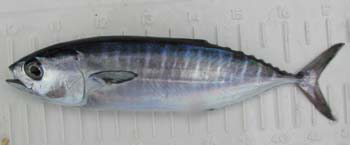
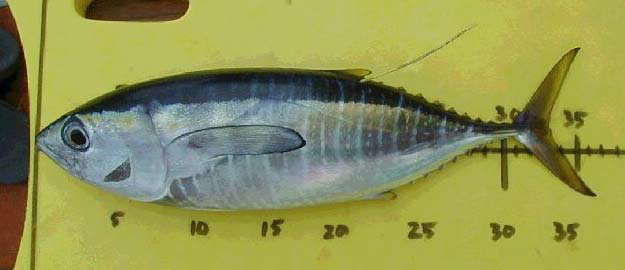
Small or juvenile Thunnus albacares less than ~40 cm FL can be confidently identified using a combination of the following external features:
- Silver/white markings in regularly spaced, vertical lines and alternating lines of spots in the form of a chevron pattern, extending forward of pectoral-fin insertion
- Obvious demarcation between marked and unmarked region below pectoral fin base (when in fresh condition)
- Head shorter and smaller relative to fork length
- Eyes smaller and rounder in shape
- Pectoral fins short and rounded at tips
- Torpedo-like body shape. Body profile forming a shallow arc from snout to caudal peduncle
- Caudal fin sometimes yellowish
Adult (greater than ~40 cm FL)
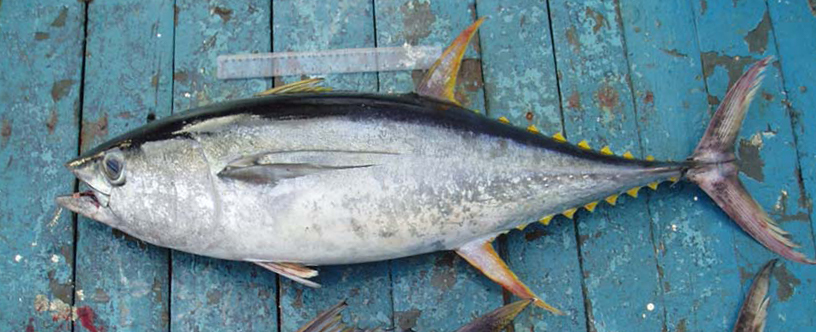

Adult Thunnus albacares can be confidently identified using a combination of the following external features:
- Silver/white markings in regularly spaced, vertical bars alternating with spots in the form of a chevron pattern, extending to level with pectoral-fin insertion
- Dark blue-black back may be separated from bright yellow mid-lateral band by a thin, bright blue band
- Clear demarcation between marked and unmarked region below pectoral fin base (when in fresh condition)
- Head shorter and smaller relative to fork length
- Eyes smaller and rounder in shape
- Pectoral fins moderate in length, not extending beyond second dorsal fin, bluntly rounded tip
- Second dorsal fin and anal fin yellow, elongated
- A distinct notch in central portion of trailing edge of caudal fin
Fresh condition
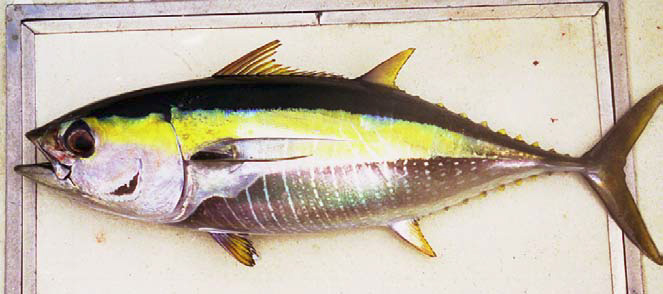

Thunnus albacares in fresh condition can be confidently identified by a combination of the following external features:
- Silver/white markings in regularly spaced, vertical bars alternating with spots in the form of a chevron pattern, extending to level with pectoral-fin insertion
- Dark blue-black back may be separated from bright yellow mid-lateral band by a thin, bright blue band
- Clear demarcation between marked and unmarked region below pectoral fin base
- Head shorter and smaller relative to fork length
- Eyes smaller and rounder in shape
- Pectoral fins moderate in length, not extending beyond second dorsal fin, bluntly rounded tip (if intact)
- A distinct notch in central portion of trailing edge of caudal fin
Less than fresh to poor condition

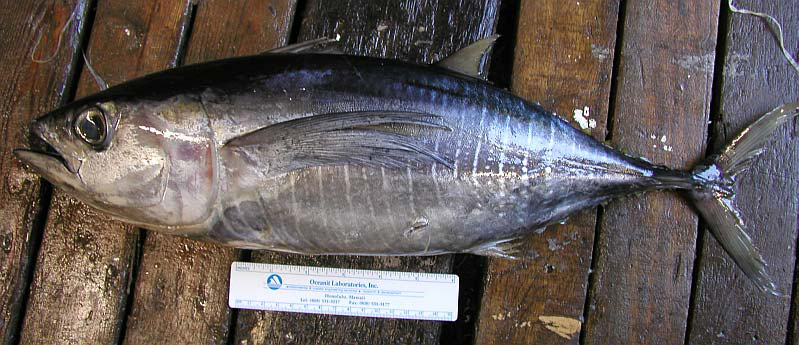
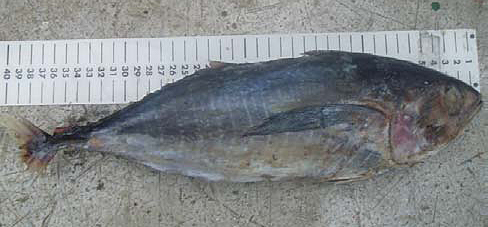

Thunnus albacares in less than fresh to poor condition may display faded, partial or absent markings and/or colouration. They may also display damaged fins and/or disfigured shape due to freezing, transport and storage. Individuals in this condition should be identified by using a combination of the following external features, and also internal features if external are unavailable:
- Remnants of silver/white markings in regularly spaced, vertical bars alternating with spots in the form of a chevron pattern, extending to level with pectoral-fin insertion (if visible)
- Eyes smaller and rounder in shape (if intact)
- Pectoral fins moderate in length, not extending beyond second dorsal fin, bluntly rounded tip (if intact)
- A distinct notch in central portion of trailing edge of caudal fin (if intact)
- Ventral surface of liver without striations, right lobe elongated
- Swimbladder usually deflated or partly inflated, occupying anterior portion of the body cavity
Found in warm temperate and tropical waters circumglobally.
Pelagic and oceanic. Found within a temperature range of 15–31 °C and at depths from the surface to 250 m.
Feeds on various fishes, cephalopods and crustaceans. Schools by size, in same species or multi-species groups. Yellowfin are highly migratory, traveling large distances for feeding and spawning purposes. This species is fast growing and highly productive, but with length and age of maturity varying depending on location. In the Western Pacific, length at first maturity was recorded as 73 cm FL, with 50% of individuals becoming mature at 104.6–107.9 cm FL.1 In the Western Central Pacific Ocean the smallest recorded mature female was 84 cm FL, with an estimated 50% of females becoming mature at 95 cm FL.2 In the Eastern Pacific, length where 50% of individuals become mature ranged between 92–96 cm FL for females and males respectively, corresponding to ~2.1 years.3 Spawning occurs all year throughout their distribution where sea surface temperatures are 24 °C or above almost exclusively at night.3 Maximum age varies by location, estimates include 4.8 years in the Pacific,4 6.5 years in the Western Pacific5 and up to 8 years in the Atlantic.6
A prominent species in the Indonesian tuna fisheries, both as juvenile and adult fish. Caught by several gear types including purse-seine, longline, pole and line, handline, troll-line and gill-net, and for all but longline and gill-net, the fishing frequently includes use of Fish Aggregating Devices (FADs). Adult yellowfin are caught by longline, by handline on FADs at depths of 150–250 m, and in surface waters using kite and lure fishing.
Thunnus alalunga
Albacore
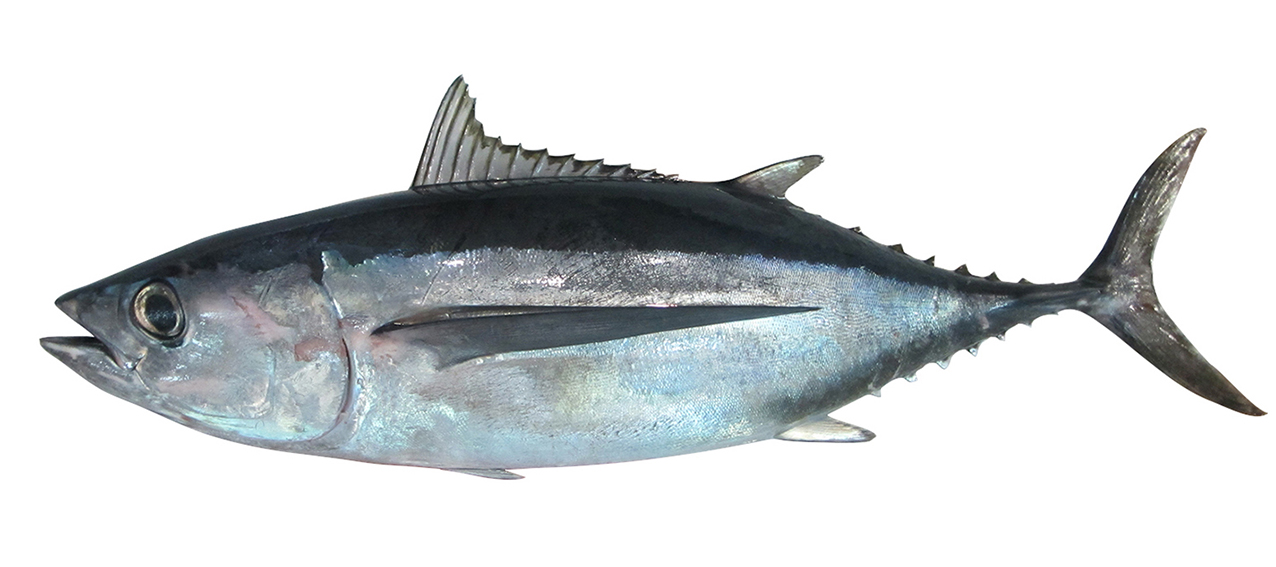
Thunnus alalunga differs in having very long pectoral fins, extending to second dorsal finlet (vs. moderately long, not reaching posterior of second dorsal-fin base); white/silver horizontal to oblique, incomplete stripes present in stressed live, and freshly dead specimens only, no markings in long dead specimens (vs. white/silver body markings in regularly spaced, vertical lines and alternating lines of spots in a ‘chevron’ pattern); caudal fin with white posterior margin (vs. caudal fin yellowish/silver); ventral surface of liver without striations, right lobe elongated (vs. striations, lobes roughly equal in length) and 25–31 gill rakers on first gill arch (vs. 26–34).
Thunnus maccoyii
Southern bluefin tuna
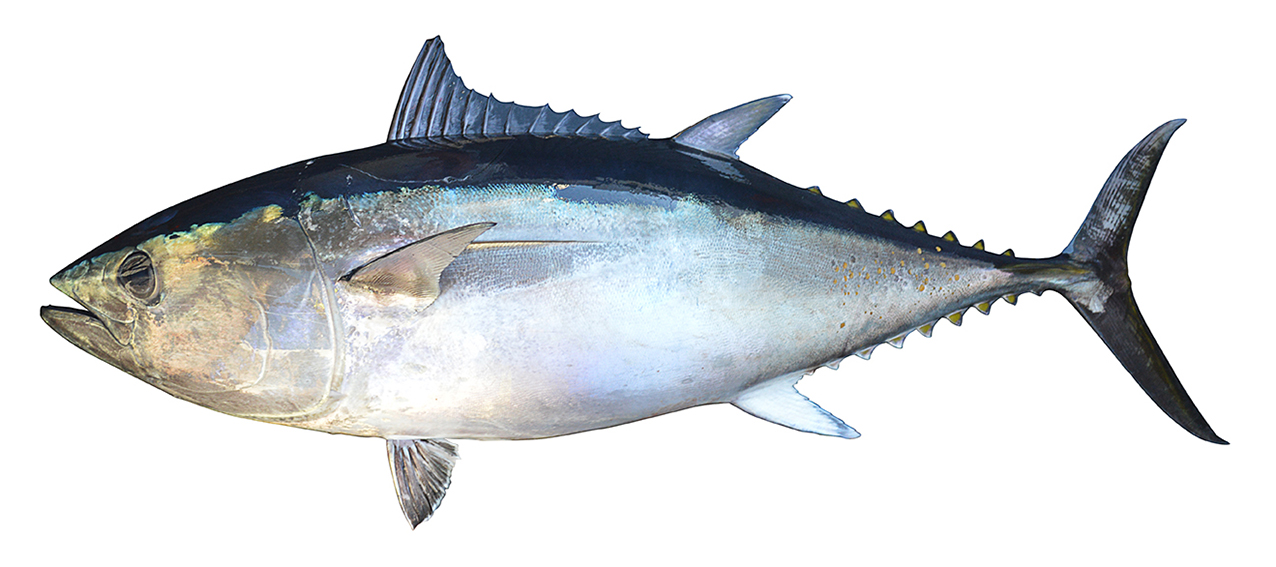
Thunnus maccoyii differs in having short pectoral fins, not reaching interdorsal space (vs. moderately long, but not reaching posterior of second dorsal-fin base); a series of white/silver irregularly spaced, often broken or incomplete vertical stripes present in stressed live , and freshly dead specimens only (vs. white/silver body markings in regularly spaced, vertical lines and alternating lines of spots in a ‘chevron’ pattern); ventral surface of liver striated, lobes roughly equal in length (vs. not striated, right lobe elongate); 31–34 gill rakers on first gill arch (vs. 26–34) and a median keel yellow in adults (vs. dark).
Thunnus obesus
Bigeye tuna
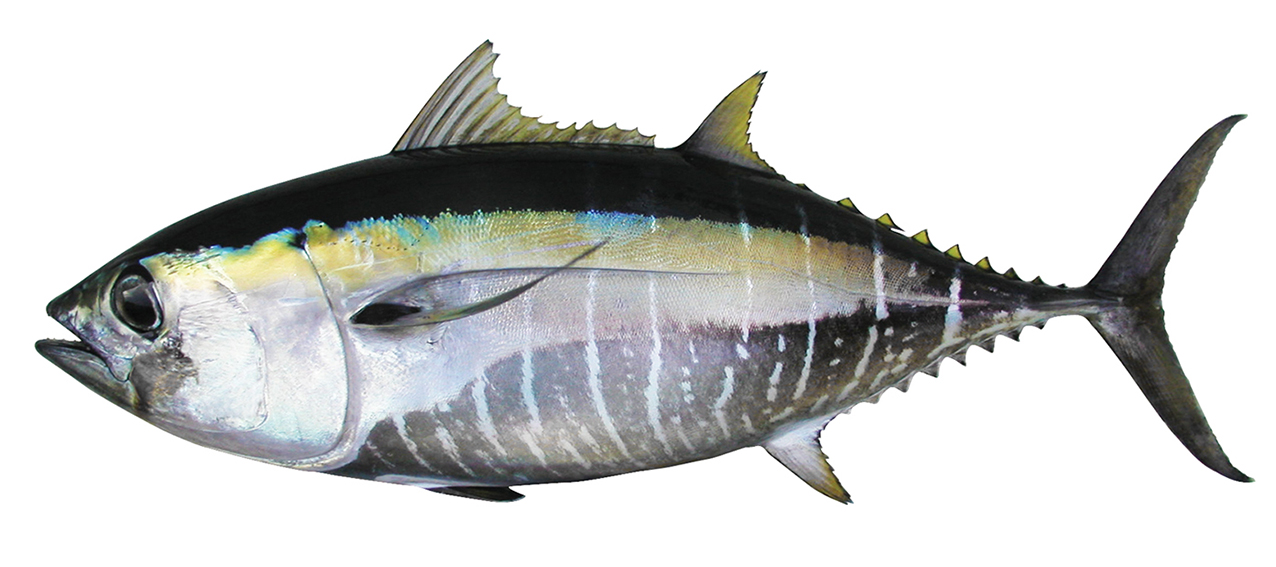
Thunnus obesus differs in having a greater head length and depth (vs. smaller) and larger eye diameter (vs. smaller) for a given FL; and being more elliptical in shape (vs. round); body deep and rounded (vs. more slender and elongate); pectoral fins very long, tips tapering to a thin flexible point (in adults) (vs. moderately long extending to base of second dorsal fin, broad and stiff); pectoral fins arc-shaped when viewed from above (vs. straight); white/silver body markings in irregularly spaced, sometimes broken, vertical lines only, mostly confined to the lower half and rear of the body (in fresh condition) (vs. white/silver body markings in regularly spaced, vertical lines and alternating lines of spots in a ‘chevron’ pattern on the upper and lower portion of the body (in fresh condition)); yellow finlets edged with black (vs. black edging thin or absent); the central portion of trailing edge of caudal fin a smooth crescent-shaped (vs. a distinct ‘V’ or ‘M’ shaped notch) and ventral surface of liver without striations, right lobe elongated (vs. striations, lobes roughly equal in length).
Thunnus orientalis
Pacific bluefin tuna
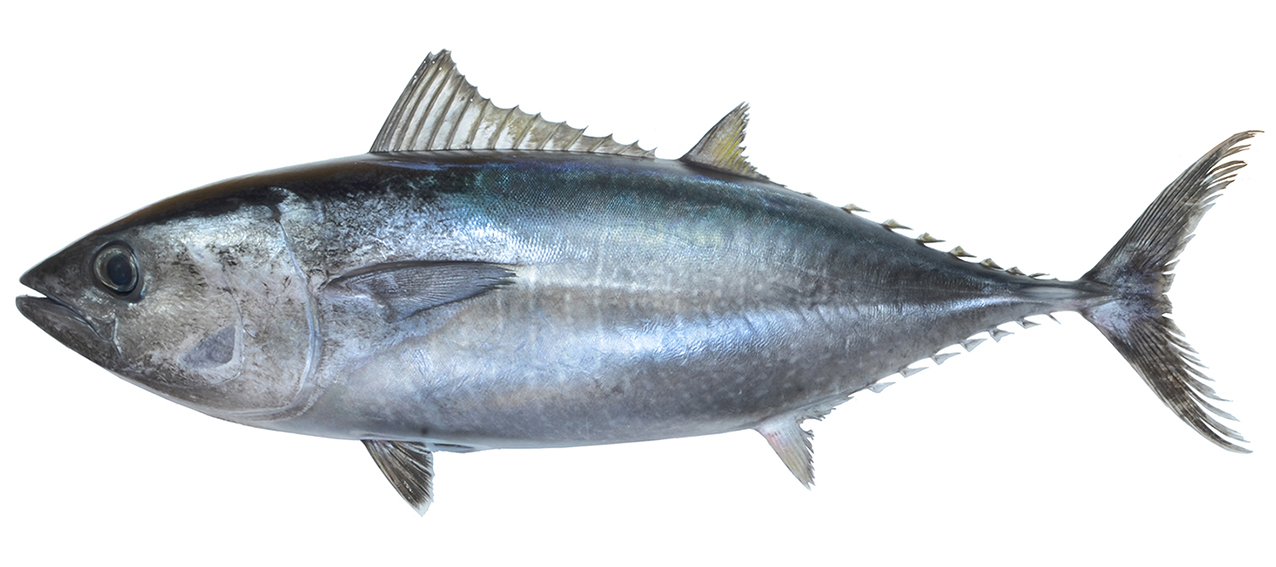
Thunnus orientalis differs in having short pectoral fins, never reaching past interdorsal space (vs. moderate length, not extending beyond end of second dorsal-fin base); white/silver markings as vertical lines and alternating lines of spots, mostly confined to lower portion of body (vs. white/silver body markings in regularly spaced, vertical lines and alternating lines of spots in a ‘chevron’ pattern) and ventral surface of liver striated, lobes roughly equal in length (vs. not striated, right lobe elongate).
Thunnus tonggol
Longtail tuna
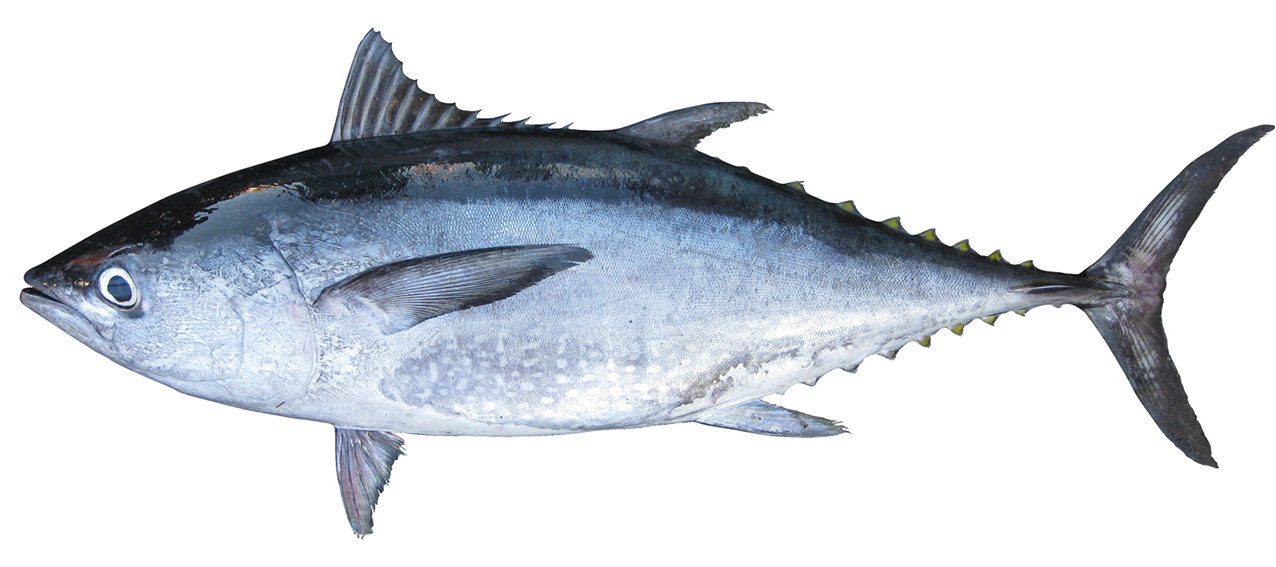
Thunnus tonggol differs in having shorter pectoral fins, not reaching the origin of the second dorsal fin (vs. moderately long, reaching beyond the origin of second dorsal fin); posterior portion of body (from deepest point to caudal peduncle) long relative to FL (vs. moderate); horizontal rows of white/silver elongate spots on belly (vs. white/silver body markings in regularly spaced, vertical lines and alternating lines of spots in a ‘chevron’ pattern) and 19–27 gill rakers on first gill arch (vs. 26–34).
- Itano DG. The reproductive biology of yellowfin tuna (Thunnus albacares) in Hawaiian waters and the western tropical Pacific Ocean: project summary. University of Hawaii, Joint Institute for Marine and Atmospheric Research Hawaii; 2000.
- Hampton J, Fournier DA. A spatially disaggregated, length-based, age-structured population model of yellowfin tuna (Thunnus albacares) in the western and central Pacific Ocean. Marine and Freshwater Research. 2001;52(7):937–63.
- Schaefer KM. Reproductive biology of yellowfin tuna (Thunnus albacares) in the eastern Pacific Ocean. Inter-Am Trop Tuna Comm Bull. 1998;21:201–72.
- Wild A. Growth of yellowfin tuna, Thunnus albacares, in the eastern Pacific Ocean based on otolith increments. Inter-American Tropical Tuna Commission Bulletin. 1986;18(6):421–82.
- Lehodey P, Leroy B. Age and growth of yellowfin tuna (Thunnus albacares) from the western and central Pacific Ocean as indicated by daily growth increments and tagging data. WP YFT-2, SCTB. 1999;12:16–23.
- IGFA. Database of IGFA angling records until 2001. IGFA Fort Lauderdale, USA; 2001.
-
Osteichthyes
Bony Fish
-
-
Carangidae
Trevallies, queenfish, scads etc.
-
- Genus Alectis
- Genus Alepes
- Genus Gnathanodon
- Genus Megalaspis
- Genus Naucrates
- Genus Parastromateus
- Genus Selaroides
- Genus Seriolina
- Genus Atule
- Genus Elagatis
- Genus Carangoides
- Genus Decapterus
- Genus Caranx
- Genus Scomberoides
- Genus Selar
- Genus Seriola
- Genus Trachinotus
- Genus Ulua
-
- Genus Uraspis
-
Atropus atropos
Cleftbelly trevally
-
Serranidae
Groupers
-
- Genus Aethaloperca
-
- Genus Cephalopholis
-
-
Cephalopholis aitha
Rusty hind
-
Cephalopholis sonnerati
Tomato grouper
-
Cephalopholis argus
Peacock grouper
-
Cephalopholis cyanostigma
Bluespotted grouper
-
Cephalopholis miniata
Red coral grouper
-
Cephalopholis sexmaculata
Saddle grouper
-
Cephalopholis aurantia
Golden grouper
-
Cephalopholis boenak
Chocolate grouper
-
Cephalopholis microprion
Freckled grouper
-
Cephalopholis formosa
Bluelined grouper
-
Cephalopholis polleni
Harlequin grouper
-
Cephalopholis urodeta
Darkfin grouper
-
Cephalopholis spiloparaea
Strawberry grouper
-
Cephalopholis leopardus
Leopard grouper
-
Cephalopholis igarashiensis
Garish grouper
-
Cephalopholis aitha
- Genus Anyperodon
- Genus Caprodon
- Genus Chromileptes
- Genus Epinephelus
-
-
Epinephelus bontoides
Palemargin grouper
-
Epinephelus kupangensis
Kupang grouper
-
Epinephelus multinotatus
White-blotched grouper
-
Epinephelus morrhua
Comet grouper
-
Epinephelus quoyanus
Longfin grouper
-
Epinephelus spilotoceps
Foursaddle grouper
-
Epinephelus erythrurus
Cloudy grouper
-
Epinephelus polystigma
White-dotted grouper
-
Epinephelus amblycephalus
Banded grouper
-
Epinephelus sexfasciatus
Sixbar grouper
-
Epinephelus areolatus
Areolate grouper
-
Epinephelus bleekeri
Bleeker’s grouper
-
Epinephelus coeruleopunctatus
Whitespotted grouper
-
Epinephelus coioides
Orangespotted grouper
-
Epinephelus corallicola
Coral grouper
-
Epinephelus cyanopodus
Speckled grouper
-
Epinephelus undulosus
Wavylined grouper
-
Epinephelus epistictus
Dotted grouper
-
Epinephelus fasciatus
Blacktip grouper
-
Epinephelus flavocaeruleus
Blue and yellow grouper
-
Epinephelus heniochus
Brindle grouper
-
Epinephelus lanceolatus
Giant grouper
-
Epinephelus miliaris
Netfin grouper
-
Epinephelus retouti
Redtipped grouper
-
Epinephelus stictus
Blackdotted grouper
-
Epinephelus fuscoguttatus
Brownmarbled grouper
-
Epinephelus latifasciatus
Striped grouper
-
Epinephelus longispinis
Longspine grouper
-
Epinephelus maculatus
Highfin grouper
-
Epinephelus magniscuttis
Spotted grouper
-
Epinephelus malabaricus
Malabar grouper
-
Epinephelus ongus
Whitestreaked grouper
-
Epinephelus poecilonotus
Dotdash grouper
-
Epinephelus polyphekadion
Camouflage grouper
-
Epinephelus radiatus
Obliquebanded grouper
-
Epinephelus rivulatus
Halfmoon grouper
-
Epinephelus faveatus
Indian grouper
-
Epinephelus hexagonatus
Starspotted grouper
-
Epinephelus macrospilos
Snubnose grouper
-
Epinephelus melanostigma
Blackspot grouper
-
Epinephelus bontoides
- Genus Giganthias
- Genus Gracila
- Genus Liopropoma
-
-
Liopropoma swalesi
Swales' basslet
-
Liopropoma randalli
Indian basslet
-
Liopropoma multilineatum
Manyline perch
-
Liopropoma dorsoluteum
Yellowback basslet
-
Liopropoma collettei
Collette's basslet
-
Liopropoma lemniscatum
Ribbon basslet
-
Liopropoma mitratum
Pinstripe basslet
-
Liopropoma africanum
African basslet
-
Liopropoma susumi
Meteor perch
-
Liopropoma swalesi
- Genus Odontanthias
- Genus Plectranthias
- Genus Chelidoperca
-
- Genus Diploprion
-
Genus Variola
Lyretail
- Genus Plectropomus
- Genus Hyporthodus
-
Pseudanthias squamipinnis
Scalefin anthias
-
Sacura parva
Little fairy basslet
-
Selenanthias analis
Pearlspot fairy basslet
-
Epinephelus merra
Honeycomb grouper
-
Aethaloperca rogaa
Redmouth grouper
-
Stromateidae
Pomfrets
-
Coryphaenidae
Dolphinfishes
-
Balistidae
Triggerfishes
-
Haemulidae
Grunts, sweetlips
-
- Genus Diagramma
- Genus Plectorhinchus
-
-
Plectorhinchus albovittatus
Giant sweetlips
-
Plectorhinchus chaetodonoides
Harlequin sweetlips
-
Plectorhinchus chrysotaenia
Goldlined sweetlips
-
Plectorhinchus flavomaculatus
Yellowspotted sweetlips
-
Plectorhinchus gibbosus
Humpback sweetlips
-
Plectorhinchus lessonii
Striped sweetlips
-
Plectorhinchus lineatus
Lined sweetlips
-
Plectorhinchus polytaenia
Ribbon sweetlips
-
Plectorhinchus unicolor
Sombre Sweetlips
-
Plectorhinchus vittatus
Oriental sweetlips
-
Plectorhinchus pica
Painted sweetlip
-
Plectorhinchus albovittatus
- Genus Pomadasys
-
Monacanthidae
Leatherjackets
-
Lutjanidae
Snappers
-
- Genus Aphareus
- Genus Etelis
-
Genus Lutjanus
Snapper
-
-
Lutjanus dodecacanthoides
Sunbeam snapper
-
Lutjanus argentimaculatus
Mangrove jack
-
Lutjanus bengalensis
Bengal snapper
-
Lutjanus biguttatus
Twospot snapper
-
Lutjanus bitaeniatus
Indonesian snapper
-
Lutjanus bohar
Red bass
-
Lutjanus boutton
Button snapper
-
Lutjanus carponotatus
Spanish flag
-
Lutjanus decussatus
Chequered snapper
-
Lutjanus ehrenbergii
Ehrenberg's snapper
-
Lutjanus erythropterus
Crimson snapper
-
Lutjanus fulviflamma
Blackspot snapper
-
Lutjanus fulvus
Blacktail snapper
-
Lutjanus gibbus
Paddletail snapper
-
Lutjanus johnii
Golden snapper
-
Lutjanus kasmira
Common bluestripe snapper
-
Lutjanus lemniscatus
Darktail snapper
-
Lutjanus lunulatus
Lunartail snapper
-
Lutjanus lutjanus
Bigeye snapper
-
Lutjanus malabaricus
Malabar snapper
-
Lutjanus maxweberi
Pygmy snapper
-
Lutjanus mizenkoi
Mizenko's snapper
-
Lutjanus monostigma
Onespot snapper
-
Lutjanus papuensis
Papuan snapper
-
Lutjanus quinquelineatus
Fivelined snapper
-
Lutjanus rivulatus
Speckled snapper
-
Lutjanus rufolineatus
Goldenlined snapper
-
Lutjanus russellii
Russell's snapper
-
Lutjanus sebae
Red emperor
-
Lutjanus semicinctus
Black-banded snapper
-
Lutjanus timoriensis
Timor snapper
-
Lutjanus vitta
Brownstripe snapper
-
Lutjanus xanthopinnis
Yellowfin snapper
-
Lutjanus dodecacanthoides
- Genus Pristipomoides
-
-
Pristipomoides argyrogrammicus
Ornate jobfish
-
Pristipomoides auricilla
Goldflag jobfish
-
Pristipomoides filamentosus
Crimson jobfish
-
Pristipomoides flavipinnis
Goldeneye jobfish
-
Pristipomoides multidens
Goldband jobfish
-
Pristipomoides sieboldii
Lavender jobfish
-
Pristipomoides typus
Sharptooth jobfish
-
Pristipomoides zonatus
Oblique-banded snapper
-
Pristipomoides argyrogrammicus
- Genus Macolor
- Genus Paracaesio
- Genus Pinjalo
-
Lipocheilus carnolabrum
Tang's snapper
-
Symphorichthys spilurus
Sailfin snapper
-
Symphorus nematophorus
Chinamanfish
-
Aprion virescens
Green jobfish
-
Gempylidae
Snake mackerels
-
- Genus Rexea
-
Diplospinus multistriatus
Striped escolar
-
Nealotus tripes
Black snake mackerel
-
Neoepinnula orientalis
Sackfish
-
Nesiarchus nasutus
Black gemfish
-
Gempylus serpens
Snake mackerel
-
Lepidocybium flavobrunneum
Escolar
-
Promethichthys prometheus
Singleline Gemfish
-
Ruvettus pretiosus
Oilfish
-
Thyrsitoides marleyi
Black Snoek
-
Istiophoridae
Billfishes
-
Scombridae
Tunas & Mackerels
-
-
Genus Auxis
Frigate & bullet tunas
-
Genus Rastrelliger
Chub mackerel
-
Genus Scomberomorus
Mackerel
-
Genus Thunnus
True tunas
-
Acanthocybium solandri
Wahoo
-
Euthynnus affinis
Mackerel tuna
-
Grammatorcynus bilineatus
Double-lined mackerel
-
Gymnosarda unicolor
Dogtooth tuna
-
Katsuwonus pelamis
Skipjack tuna
-
Sarda orientalis
Striped bonito
-
Scomber australasicus
Blue mackerel
-
Genus Auxis
-
Xiphiidae
Broadbill swordfish
-
Sphyraenidae
Barracudas
-
Lethrinidae
Emperors
-
- Genus Gymnocranius
-
-
Gymnocranius elongatus
Forktail large-eye bream
-
Gymnocranius frenatus
Yellowsnout large-eye bream
-
Gymnocranius grandoculis
Blue-lined large-eye bream
-
Gymnocranius microdon
Bluespotted large-eye bream
-
Gymnocranius euanus
Japanese large-eye bream
-
Gymnocranius griseus
Grey large-eye bream
-
Gymnocranius satoi
Blacknape large-eye bream
-
Gymnocranius obesus
Obese large-eye bream
-
Gymnocranius elongatus
-
Genus Lethrinus
Emperor
-
-
Lethrinus atkinsoni
Yellowtail emperor
-
Lethrinus erythracanthus
Yellowfin emperor
-
Lethrinus erythropterus
Longfin emperor
-
Lethrinus genivittatus
Longspine emperor
-
Lethrinus harak
Thumbprint emperor
-
Lethrinus lentjan
Pinkear emperor
-
Lethrinus microdon
Smalltooth Emperor
-
Lethrinus nebulosus
Spangled emperor
-
Lethrinus obsoletus
Orangestriped Emperor
-
Lethrinus olivaceus
Longface emperor
-
Lethrinus ornatus
Ornate emperor
-
Lethrinus rubrioperculatus
Spotcheek emperor
-
Lethrinus semicinctus
Blackblotch emperor
-
Lethrinus variegatus
Slender emperor
-
Lethrinus xanthochilus
Yellowtip emperor
-
Lethrinus ravus
Drab emperor
-
Lethrinus reticulatus
Red snout emperor
-
Lethrinus conchyliatus
Maldive emperor
-
Lethrinus laticaudis
Grass emperor
-
Lethrinus miniatus
Trumpet emperor
-
Lethrinus atkinsoni
- Genus Monotaxis
-
Gnathodentex aureolineatus
Striped Large-eye Bream
-
Lethrinus amboinensis
Ambon emperor
-
Wattsia mossambica
Mozambique large-eye bream
-
Carangidae
-
Elasmobranchii
Cartilaginous Fish
-
-
Stegostomatidae
Zebra shark
-
-
Galeocerdidae
Tiger shark
-
Mobulidae
Manta and devil rays
-
Alopiidae
Thresher sharks
-
Lamnidae
Mackerel sharks
-
Carcharhinidae
Whaler sharks
-
- Genus Carcharhinus
-
-
Carcharhinus albimarginatus
Silvertip shark
-
Carcharhinus altimus
Bignose shark
-
Carcharhinus amblyrhynchoides
Graceful shark
-
Carcharhinus amblyrhynchos
Grey reef shark
-
Carcharhinus amboinensis
Pigeye shark
-
Carcharhinus borneensis
Borneo shark
-
Carcharhinus brevipinna
Spinner shark
-
Carcharhinus falciformis
Silky shark
-
Carcharhinus leucas
Bullshark
-
Carcharhinus limbatus
Common blacktip shark
-
Carcharhinus longimanus
Oceanic whitetip shark
-
Carcharhinus macloti
Hardnose shark
-
Carcharhinus melanopterus
Blacktip reef shark
-
Carcharhinus obscurus
Dusky shark
-
Carcharhinus plumbeus
Sandbar shark
-
Carcharhinus sealei
Blackspot shark
-
Carcharhinus sorrah
Spot-tail shark
-
Carcharhinus tilstoni
Australian blacktip shark
-
Carcharhinus tjutjot
Indonesian whaler shark
-
Carcharhinus albimarginatus
- Genus Rhizoprionodon
-
Glyphis gangeticus
Ganges shark
-
Lamiopsis tephrodes
Borneo broadfin shark
-
Loxodon macrorhinus
Sliteye shark
-
Negaprion acutidens
Sicklefin lemon shark
-
Prionace glauca
Blue shark
-
Scoliodon macrorhynchos
Pacific spadenose shark
-
Triaenodon obesus
Whitetip reef shark
-
Stegostomatidae
-
Crustaceans
Crabs, Lobsters, Shrimps, etc.